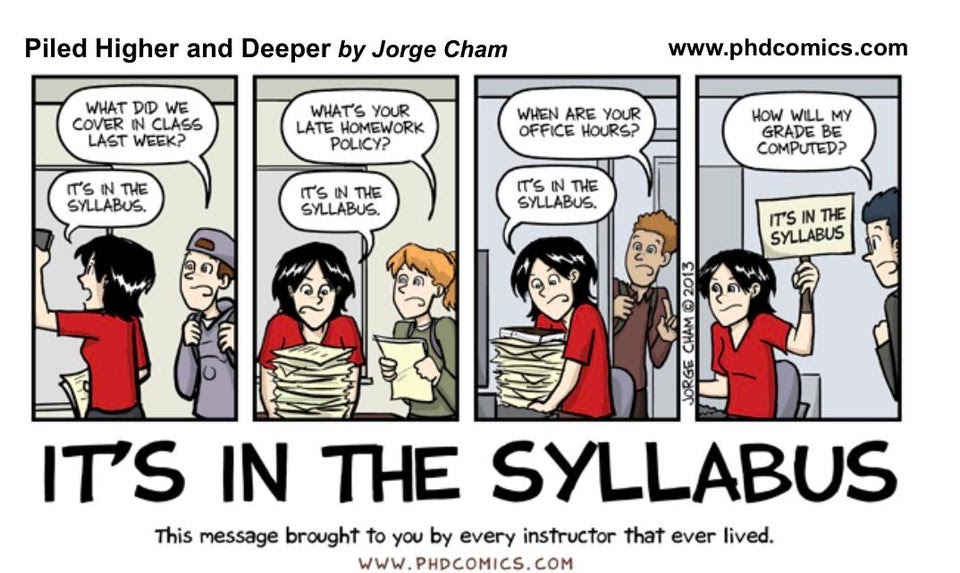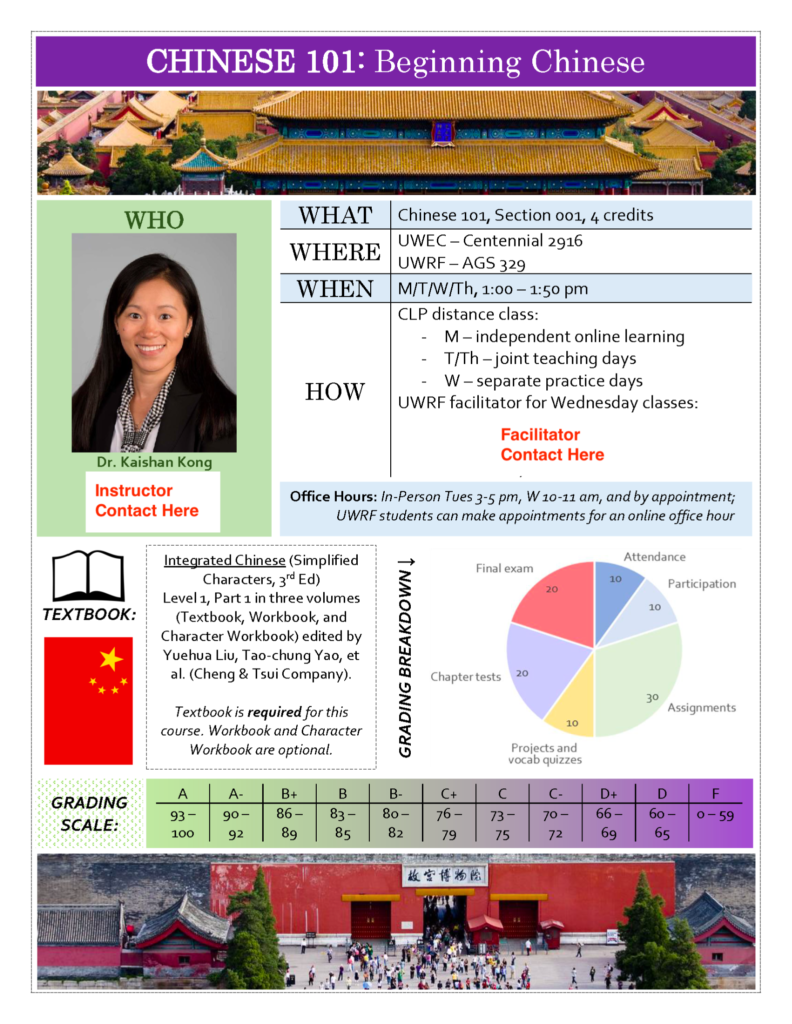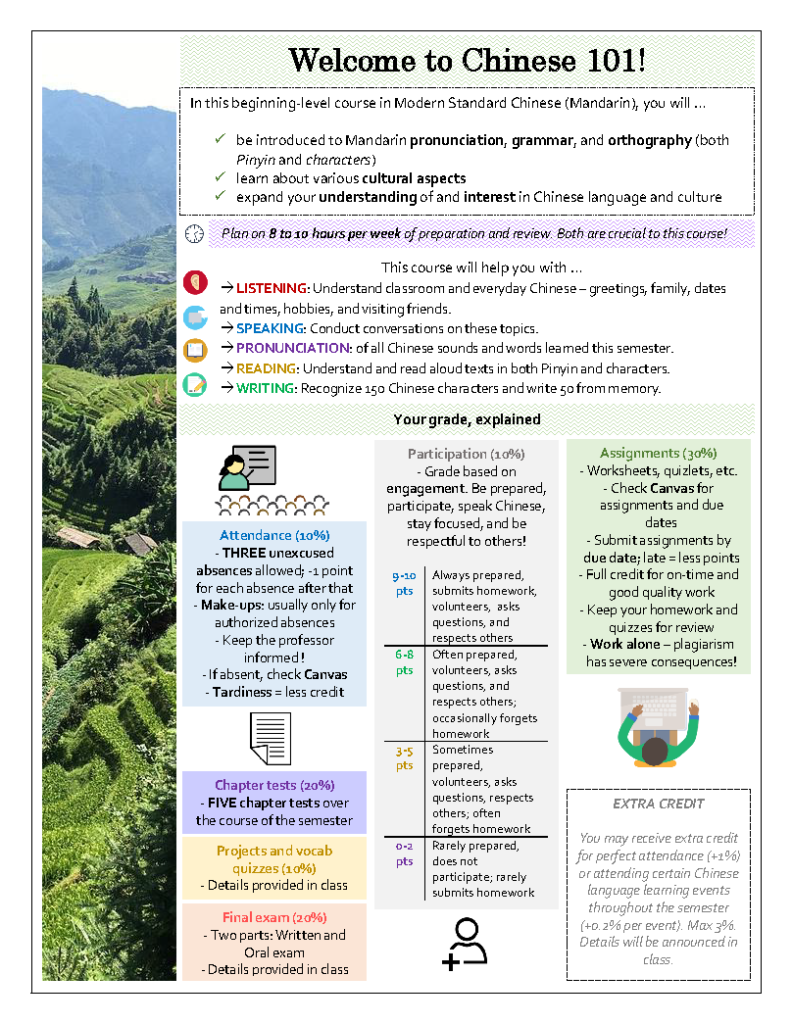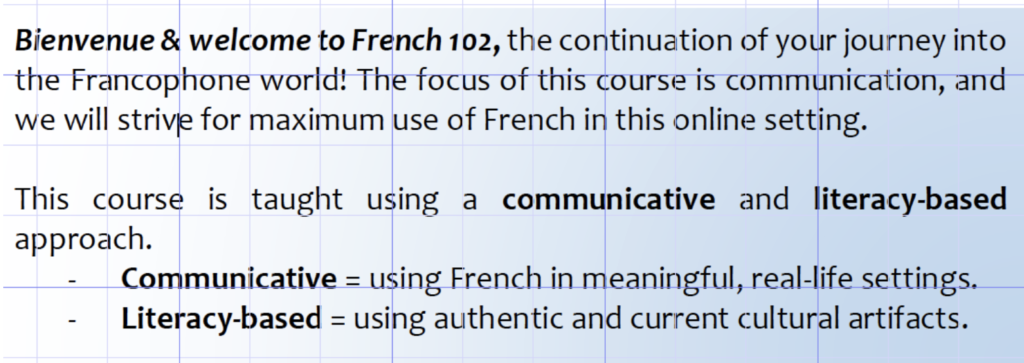
The Power of Media-Based Syllabi: If Only Students Knew What the Syllabus Said
By Lauren Rosen, University of Wisconsin, and Kate Grovergrys, Madison Area Technical College


DOI: https://www.doi.org/10.69732/LHCN1531

Used with permission from: “Piled Higher and Deeper” by Jorge Cham www.phdcomics.com
Students are most successful when they know what to expect while learning a language. A packed, wordy syllabus doesn’t align with today’s learner preferences. For example, students tend to skim and scan long passages. They look for the gist, and as instructors, we need to purposefully steer them towards the most significant details. Also, students are more engaged when interacting with content both online and in class as opposed to passively reading content. Giving students the opportunity to process and analyze information moves them from understanding and remembering to applying what they know. Why not apply this knowledge of Bloom’s Taxonomy to all aspects of our course, including the syllabus? Media-based syllabi grab students’ attention, drive interaction, and check knowledge of the most important details.
A syllabus is important to the set-up of courses so that students are clear on expectations, outcomes, and their role in reaching those outcomes. Committing to these expectations is what leads to success as a language student. Research indicates that when students are able to connect with content visually it is more likely to be committed to memory. According to eLearning Design (2014), “visuals summarize content into smaller, and easier to process chunks, and when you select the right visuals, they offer more comprehensibility than text-based explanations or only audios.” A well-designed media-based syllabus, therefore, can reduce many of the common questions that instructors repeatedly address.
If students are to know and apply information, it needs to be presented with opportunities to engage and interact. Technology can be used to present content visually, and the syllabus should be no exception. Students are more likely to remember the visually-enhanced content that is in a graphical or video media-based syllabus. The media grabs student attention, provides visuals that help students commit content to memory, and drives their connection and interaction with it. Moreover, adding a simple concept check (no stakes quiz) in your learning management system (LMS) will help students identify the most important details in the syllabus and will help them commit at least the location of that information to memory, if not the content itself.
You may be wondering, how do I create a media-based syllabus? As with everything created with technology, there are many tools and options for this purpose. Choose one that you already know. The following are some sample pages of a syllabus created using Microsoft Word. Other options might be to use PowerPoint and save the slides as graphics, or use an online graphic tool such as Canva.


The key is to find the details in all the wording of your current syllabus and move what you can to charts and bullet points so it is easier to skim through. As you can see with the use of text boxes, text color, shading, images, and clipart, it is quite easy to draw attention to the most important aspects of your course. As you determine what to make graphical and perhaps what to leave out, consider which elements students are most likely to refer back to throughout your course. For example, reviewing the different course components that make up the final grade is a common feature that students wish to find in the syllabus, so this would be a good element to make visual. On the other hand, campus/school-wide policies that you are required to include can remain in paragraphs at the end of your syllabus for students to review if/when needed (I was caught plagiarizing, what’s going to happen to me?). Focus the media transformation on the first couple of pages that highlight the everyday concerns common to most students.
According to Wooley and Hay (2004),
“Recall is most effective when [the] reader can decode the words, have an understanding of the vocabulary and the meaning of the sentence, and use imagery as a comprehension strategy… Effective imagery generation increases the capacity of working memory during reading by organising details and propositions into chunks, which are carried along during reading. The degree of involvement, enjoyment, and interest in reading are also enhanced by the generation of meaningful images.”
To provide a more clear idea of how one moves from text to graphic, let’s take a look at a couple parts of a typical Elementary French Syllabus.
Traditional syllabus in paragraph form:
Bienvenue!
Welcome to French 102! This course is the second semester of French, the continuation of your journey into the Francophone world. The focus of this course is communication, and we will strive for maximum use of French in this online setting. The approach used in this course is communicative and literacy-based. “Communicative” means that you will learn to use French in meaningful ways and real-life settings. “Literacy-based” means you will encounter the French language through authentic and contemporary cultural artifacts.
In a graphic syllabus it might look something like this:

Other common elements of a traditional syllabus might look like this:
Your grade, explained:
| Oral Participation | 20% |
| Quizzes | 15% |
| Writing Journals | 10% |
| Homework | 25% |
| Projects | 15% |
| Written Examinations | 15% |
However, on a graphic syllabus it is easier for the visual learner to conceptualize the aspects of a grade that are weighted heaviest and lightest with a chart such as the following:

Through these examples you can see that less text makes it easier to read and highlights the key aspects of what a wordy paragraph would say. Also by using charts and colors it is far more clear that it is really important to participate orally and do homework in order to pass this class. It is also helpful to see that the exams are not weighted more heavily than projects and quizzes, especially for those students that don’t test well or struggle under pressure. Note that it is still helpful to keep the numbers next to the chart in case students have trouble distinguishing the sizes of the pieces of pie in the pie chart.
Another type of syllabus would be a video-based syllabus. It’s important to keep these short and precise. You can use the same technology that you would choose for creating a screencast. If you have never created a screencast, you can try Screencastify or Loom or whatever technology your school/campus supports. Once you have completed your short video you can either add pop-up questions to create a concept check using a technology like H5P or you can simply add a quick LMS quiz. Whether it is a video-based syllabus or simply an introduction video to help orient students to the course and the LMS, students appreciate making a connection from the beginning to the instructor they will be working with throughout the course. This is the first step in building that connection regardless of the course being taught in-person or online.
You may want to make sure you keep a text-based version of your syllabus available in case any of your students need it for accessibility purposes. Many of the tools that we use to create our media-based syllabi, like Microsoft Word, also have accessibility assistants that can help you to identify areas of the syllabus that may need additional support for students with disabilities. If you have any doubts about the accessibility of your syllabus, we recommend that you consult with your institution’s disability resource center.
Michelle Pacansky-Brock (2014) talks about humanizing your course with a “liquid syllabus.” The concept of “liquid content” refers to information that is widely shared, such as a viral video on the internet.
“Maybe a college course syllabus won’t become viral (for good reasons) but what if a course syllabus could transform into a content experience that students really wanted to look at and engage with, as opposed to a resource we dictated they ‘must read.’”
Through the use of media-based syllabi, we can greatly increase the odds that students will know what the syllabus says. We can grab students’ attention through the use of eye-catching graphics and/or video components. Then we can facilitate interaction and check for understanding with engaging online tools.
REFERENCES
eLearning Design Admin. (2014, July 9). Studies Confirm the Power of Visuals to Engage Your Audience in eLearning. Retrieved from https://www.shiftelearning.com/blog/bid/350326/studies-confirm-the-power-of-visuals-in-elearning.
Pacansky-Brock, M. (2014, August 13). The liquid syllabus: Are you ready? Michele Pacansky-Brock. Retrieved from https://brocansky.com/2014/08/the-liquid-syllabus-are-you-ready.html.
Woolley, G. E., & Hay, I. (2004). Using imagery as a strategy to enhance students’ comprehension of read text. In B. A. Knight & W. Scott (Eds.), Learning difficulties: Multiple perspectives (pp. 85–101). Frenchs Forest, Australia: Pearson.

I love this! I’ve been trying to edge my syllabi in this direction for a while now. There are definitely things left to improve. The pie chart for grading criteria is brilliant. Thanks for sharing!